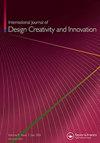Editorial
IF 2.5
Q4 ENGINEERING, MANUFACTURING
International Journal of Design Creativity and Innovation
Pub Date : 2020-01-02
DOI:10.1080/21650349.2019.1692772
引用次数: 0
Abstract
With the inauguration of the eighth volume, the International Journal of Design Creativity and Innovation (IJDCI) starts a new cycle with important novelties and renewed ambitions. First, the journal is now offered in the Science & Technology Library package, which is an extremely attractive bundle for academic libraries, research organizations and others for being the largest collection of science and technology content of Taylor and Francis with over 500 journals, 10,000 volumes and 700,000 peer-reviewed articles. We are confident that this will imply broader visibility for the research studies published in this journal and ultimately a higher impact of design creativity research on society. The second not less important novelty of 2020 is the renewal of the editorial and steering advisory boards of the journal. Thirty-seven board members (20 in the editorial board and 17 in the advisory board) from 14 different countries and with complementary areas of focus within the design creativity and innovation domain accepted the challenge to work together toward a higher recognition of both the journal in particular and the entire field of study in general. The eighth year of IJDCI starts with the editorial by former president of the Design Society, Prof. Panos Y. Papalambros from the University of Michigan, USA. In the editorial, Prof. Papalambros shares his thoughts on the interplay between education and research. A key value of academic education is the continuous update of the courses content with the most recent outcomes of research activities and the latest studies published by scholars from all over the world. Prof. Papalambros highlights the important role of design education as a means to validate design research. The editorial offers stimulating insights and points for reflection based on his large experience in the design field. The new year also starts with IJDCI being selected among the journals proposed for the PubliER 2020 Workshop. The workshop, to be held in Troyes (France) from 29 to 31 January 2020, is dedicated to support top-end early researchers in refining their scientific academic writing skills. The aim is to enable the researchers to improve their writing and publishing capacities and to polish previously written papers so as to publish them on the most pertinent international scientific journals in their fields of study. Papers dealing with design creativity submitted to PubliER 2020 will be discussed in dedicated sessions where IJDCI editors will meet the authors to advise and guide them. Early researchers will also participate as peer reviewers for other papers participating in the same session. Eventually, the process will enable the researchers to better previously written papers and end with a top-quality product to be submitted to the journal where the resulting enhanced paper has higher chances of being accepted. Therefore, we have great expectations for 2020. After all, eight is the luckiest number in the Chinese culture as its ideogram 八 sounds like 發 (fa), which means ‘wealth’ and ‘fortune’ in the Chinese language. Hopefully, Volume 8 of IJDCI will sprout under the sign of luck and prosperity for design creativity research.社论
随着第八卷的出版,《国际设计创意与创新杂志》(IJDCI)以重要的新颖性和新的雄心开启了一个新的周期。首先,该期刊现在以科技图书馆包的形式提供,这对学术图书馆、研究机构和其他机构来说是一个极具吸引力的捆绑包,因为它是泰勒和弗朗西斯最大的科技内容收藏,拥有500多份期刊、10000卷和700000篇同行评审文章。我们相信,这将意味着发表在本杂志上的研究具有更大的知名度,并最终使设计创意研究对社会产生更大的影响。2020年的第二个同样重要的新颖之处是该杂志编辑和指导咨询委员会的更新。来自14个不同国家的37名董事会成员(20名编辑委员会成员和17名咨询委员会成员)在设计创意和创新领域具有互补的重点领域,他们接受了挑战,共同努力,以提高对该杂志和整个研究领域的认识。IJDCI的第八年以美国密歇根大学设计学会前主席帕诺斯·帕帕兰布罗斯教授的社论开始。在社论中,帕帕兰布罗s教授分享了他对教育和研究之间相互作用的想法。学术教育的一个关键价值是不断更新课程内容,不断更新研究活动的最新成果和世界各地学者发表的最新研究。帕帕兰布罗斯教授强调了设计教育作为验证设计研究手段的重要作用。这篇社论基于他在设计领域的丰富经验,提供了令人振奋的见解和反思要点。新的一年也开始了,IJDCI被选为PubliER 2020研讨会的期刊之一。该研讨会将于2020年1月29日至31日在法国特鲁瓦举行,旨在支持高端早期研究人员提高他们的科学学术写作技能。其目的是使研究人员能够提高他们的写作和出版能力,并完善以前撰写的论文,以便在其研究领域最相关的国际科学期刊上发表。提交给PubliER 2020的关于设计创意的论文将在专门的会议上进行讨论,IJDCI编辑将与作者会面,为他们提供建议和指导。早期研究人员还将作为同行评审员参与同一届会议的其他论文。最终,这一过程将使研究人员能够更好地撰写之前撰写的论文,并最终将高质量的产品提交给期刊,从而提高论文被接受的几率。因此,我们对2020年抱有很大的期望。毕竟,在中国文化中,八作为表意符号是最幸运的数字八 听起来像發 (fa),在汉语中的意思是“财富”和“财富”。希望IJDCI第8卷能在设计创意研究的幸运和繁荣的标志下萌芽。
本文章由计算机程序翻译,如有差异,请以英文原文为准。
求助全文
约1分钟内获得全文
求助全文
来源期刊

International Journal of Design Creativity and Innovation
ENGINEERING, MANUFACTURING-
CiteScore
3.80
自引率
27.80%
发文量
15
期刊介绍:
The International Journal of Design Creativity and Innovation is an international publication that provides a forum for discussing the nature and potential of creativity and innovation in design from both theoretical and practical perspectives. Design creativity and innovation is truly an interdisciplinary academic research field that will interest and stimulate researchers of engineering design, industrial design, architecture, art, and similar areas. The journal aims to not only promote existing research disciplines but also pioneer a new one that lies in the intermediate area between the domains of systems engineering, information technology, computer science, social science, artificial intelligence, cognitive science, psychology, philosophy, linguistics, and related fields. The journal covers, but is not restricted to, the following topics: ·Theories on Design Creativity and Innovation ·Cognition of Design Creativity ·Innovative Process ·Inventive Process ·Analogical Reasoning for Design Creativity and Innovation ·Design Synthesis ·Method and Tools for Design Creativity and Innovation ·Representation of Design Creativity and Innovation ·Education for Design Creativity and Innovation ·Concept Generation and Inspiration.
 求助内容:
求助内容: 应助结果提醒方式:
应助结果提醒方式:


